NCERT Exemplar Class 11 Chemistry Chapter 8 Redox Reactions are part of NCERT Exemplar Class 11 Chemistry . Here we have given NCERT Exemplar Class 11 Chemistry Chapter 8 Redox Reactions.
NCERT Exemplar Class 11 Chemistry Chapter 8 Redox Reactions
Multiple Choice Questions
Single Correct Answer Type
Q1. Which of the following is not an example of redox reaction?
(a) CuO + H
2
→ Cu + H
2
0
(b) Fe
2
0
2
+ 3CO → 2Fe + 3C0
2
(c).2K + F
2
→2KF
(d) BaCl
2
+ H
2
S0
4
→BaS0
4
+ 2FIC1
Sol:
(d) BaCl
2
+ H
2
S0
4
—> BaS0
4
+ 2HC1 is not a redox reaction. It is an example of double displacement reactions.
Q2. The more positive the value of E°, the greater is the tendency of the species to get reduced. Using the standard electrode potential of redox couples given below, find out which of the following is the strongest oxidizing agent. E° values: Fe
3
+
/Fe
2+
= +0.77; I
2
(g)/I = +0.54;
Cu
2+
/Cu = +0.34; Ag
+
/Ag = +0.80 V
(a) Fe
3+
(b) I
2
(g)
(c) Cu
2+
(d) Ag
+
Sol:
(d) Since Ag
+
/Ag has highest positive value of E°, therefore, Ag
+
is the strongest oxidizing agent with highest tendency to get reduced
Q3. E° values of some redox complexes are given below. On the basis of these values choose the correct option.
E° values: Br
2
/Br
–
= +1.90; Ag
+
/Ag(s) = +0.80 Cu
2
+
/Cu(s) = +0.34; I
2
(s)/I
–
= +0.54 V
(a) Cu will reduce Br
–
(b) Cu will reduce Ag
(c) Cu will reduce I
–
(d) Cu will reduce Br
2
Sol:
(d) Copper will reduce Br
2
, if the E° of the redox reaction, 2Cu + Br
2
CuBr
2
is +ve.

Since E° of this reaction is +ve, therefore, Cu can reduce Br 2 and hence option (d) is correct.
Q4. Using the standard electrode potential, find out the pair between which redox reaction is not feasible.
E° values: Fe
3
+
/Fe
2+
= +0.77; I
2
/I
–
= +0.54;
Cu
2+
/Cu = +0.34; Ag
+
/Ag = +0.80 V
(a) Fe
3+
and I
(b) Ag
+
and Cu
(c) Fe
3+
and Cu
(d) Ag and Fe
3+
Sol: (d)
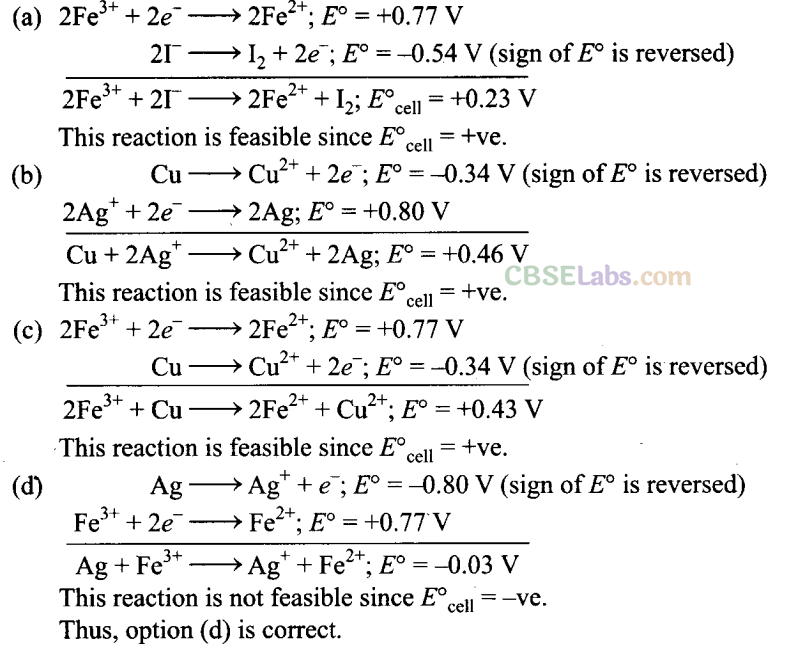
Q5. Thiosulphate reacts differently with iodine and bromine in the reactions given below:
2S
2
0
3
2_
+ I
2
→S
4
0
6
2-
+ 2I
–
S
2
0
3
2-
+ 2Br
2
+ 5H
2
0 →2S0
4
2-
+ 4Br
–
+ 10H
+
Which of the following statements justifies the above dual behaviour of thiosulphate?
(a) Bromine is a stronger oxidant than iodine.
(b) Bromine is a weaker oxidant than iodine.
(c) Thiosulphate undergoes oxidation by bromine and reduction by iodine in these reactions.
(d) Bromine undergoes oxidation and iodine undergoes reduction in these reactions.

Bromine being stronger oxidizing agent than I
2
, it oxidises S of S
2
O
2-
3
to SO
4
2-
whereas I
2
oxidises it only into S
4
O
6
2-
ion.
Q6. The oxidation number of an element in a compound is evaluated on the basis of certain rules. Which of the following rules is not correct in this respect?
(a) The oxidation number of hydrogen is always +1.
(b) The algebraic sum of all the oxidation numbers in a compound is zero.
(c) An element in the free or the uncombined state bears oxidation number zero.
(d) In all its compounds, the oxidation number of fluorine is -1.
Sol:
(a) Oxidation number of hydrogen is -1 in metal hydrides like NaH.
Q7. In which of the following compounds, an element exhibits two different oxidation states.
(a) NH
2
OH
(b) NH
4
NO
3
(c) N
2
H
4
(d) N
3
H
Sol:
(b) NH
4
NO
3
is an ionic compound consisting of NH
4
+
and NO
3
–
ion.
The oxidation number of N in two species is different as shown below:
In NH;,
Let the oxidation state of N in NH
4
+
be x.
x + 4x(+l) = +l
x = -3
In NO
3
–
Let the oxidation state of N in NO
3
–
be y,
y + 3 x (-2) = -1
y = +5
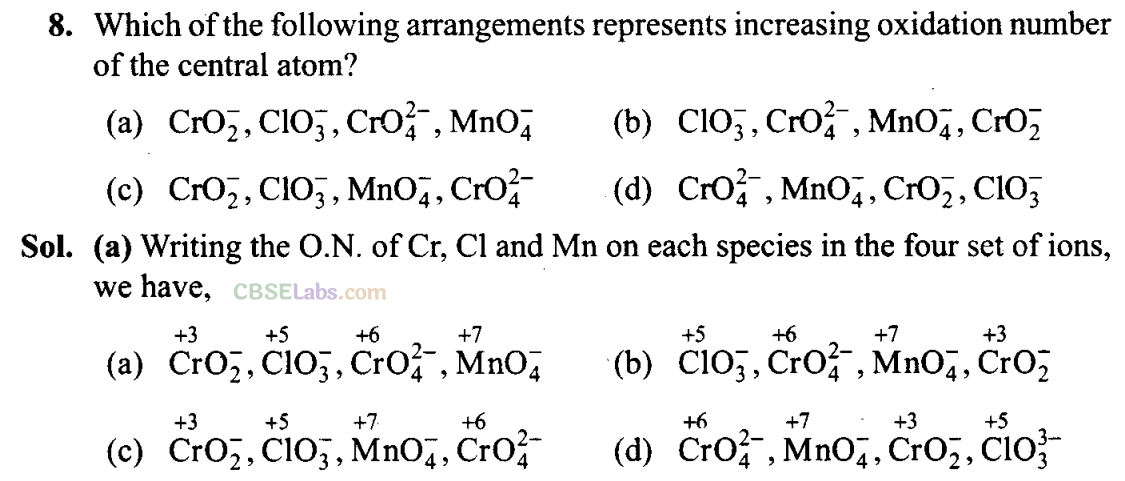
Only in arrangement (a), the O.N. of central atom increases from left to right. Therefore, option (a) is correct.
Q9. The largest oxidation number exhibited by an element depends on its outer electronic configuration. With which of the following outer electronic configurations the element will exhibit largest oxidation number?
(a) 3d
1
4s
2
(b) 3d
2
4s
2
(c) 3d
5
4s
1
(d) 3d
5
4s
2
Sol:
(d) Highest O.N. of any transition element = (n – 1)d electrons +ns electrons. Therefore, larger the number of electrons in the 3d orbitals, higher is the maximum O.N.
(a) 3d
1
4s
2
= 3; ‘
(b) 3d
2
4s
2
= 3 + 2 = 5;
(c) 3d
5
4s
1
=5 + 1=6
(d) 3d
5
4s
2
= 5+2 = 7
Q10. Identify disproportionation reaction
(a) CH
4
+ 20
2
→ C0
2
+ 2H
2
0
(b) CH
4
+ 4C1
2
→ CC1
4
+ 4HCl
(c) 2F
2
+ 20H
–
→2F
–
+ OF
2
+ H
2
0
(d) 2N0
2
+ 20H
–
→ N0
2
+ NO
–
3
+ H
2
0
Sol:
(d) Reactions in which the same substance is oxidized as well as reduced are called disproportionation reactions. Writing the O.N. of each element above its symbol in the given reactions,
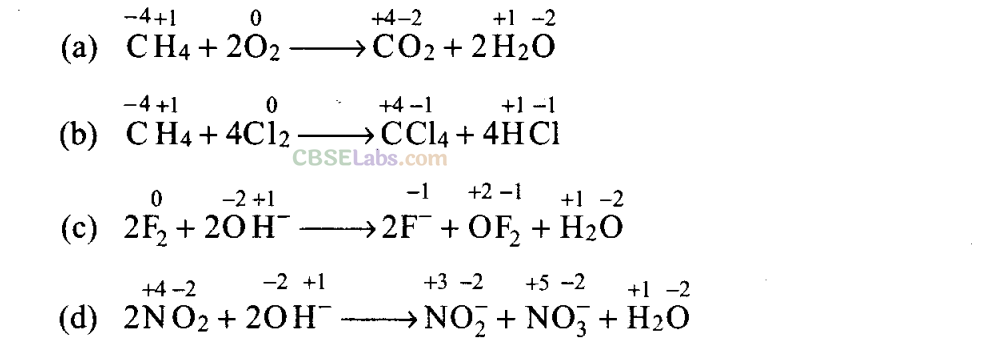
Thus, in reaction (d), N is both oxidized as well as reduced since the O.N. of N increases from +4 in N0 2 to +5 in N0 – 3 and decreases from +4 in N0 2 to +3 in N0 – 2 .
Q11. Which of the following elements does not show disproportionation tendency?
(a) Cl
(b) Br
(c) F
(d) I
Sol:
(c) Being the most electronegative element, F can only be reduced and hence it always shows an oxidation number of-1. Further, due to the absence of d-orbitals, it cannot be oxidized and hence it does not show +ve oxidation numbers. In other words, F cannot be simultaneously oxidized as well as reduced and hence does not show disproportionation reactions. Thus, option (c) is correct.
More than One Correct Answer Type
Q12. Which of the following statement(s) is/are not true about the following decomposition reaction?
2KCIO3 →2KC1 + 30
2
(a) Potassium is undergoing oxidation.
(b) Chlorine is undergoing oxidation.
(c) Oxygen is reduced.
(d) None of the species are undergoing oxidation or reduction.
Sol:
(a, b, c, d) Writing the oxidation number of each element above its symbol,

(a) The O.N. of K does not change, K. undergoes neither reduction nor oxidation. Thus, option (a) is not correct.
(b) The O.N. of chlorine decreases from +5 in KCl0
3
to -l in KCl, hence, Cl undergoes reduction.
(c) Since, O.N. of oxygen increases from -2 in KC10
3
to 0 in 0
2
, oxygen is oxidized.
(d) This statement is not correct because Cl is undergoing reduction and O is undergoing oxidation.
Q13. Identify the correct statement(s) in relation to the following reaction:
Zn + 2HCl → ZnCl
2
+ H
2
(a) Zinc is acting as an oxidant.
(b) Chlorine is acting as a reductant.
(c) Hydrogen ion is acting as an oxidant.
(d) Zinc is acting as a reductant.

(a) The O.N. of Zn increases from 0 to +2 (in ZnCl
2
) and therefore, Zn acts as a reductant and not as an oxidant. Hence, option (a) is not correct.
(b) The O.N. of Cl does not change and therefore, it neither acts as a reductant nor an oxidant. Hence, option (b) is not correct.
(c) The O.N. of H decreases from +1 in H
+
to 0 in H
2
. Therefore, H
+
acts an oxidant. This option is correct.
(d) Zinc acts as reductant because its O.N. changes from 0 to +2. This option is correct.
Q14. The exhibition of various oxidation states by an element is also related to the outer orbital electronic configuration of its atom. Atom(s) having which of the following outermost electronic configurations will exhibit more than one oxidation state in its/their compounds.
(a) 3s
1
(b) 3d
l
4s
2
(c) 3d
2
4s
2
(d) 3s
2
3p
3
Sol:
(b, c, d) Elements which have only s-electron in the valence shell do not show more than one oxidation state. Thus, element with 3s
1
as outer electronic configuration shows only one oxidation state of +1.
Transition elements, i.e., elements (b, c) having incompletely filled orbitals in the penultimate shell show variable oxidation states. Thus, element with outer electronic configuration as 3d
1
4s
2
shows variable oxidation states of +2 and +3 and the element with outer electronic configuration as 3d
2
4s
2
shows variable oxidation states of +2, +3 and +4.
p-Block elements also show variable oxidation states due to a number of reasons such as involvement of J-orbitals and inert pair effect. For example, element (d) with 3s
2
3p
3
as (i.e., P) as the outer electronic configuration shows variable oxidation states of +3 and +5 due to involvement of d-orbitals.
Q15. Identify the correct statements with reference to the given reaction.
P
4
+ 30H
–
+ 3H
2
0→ PH
3
+ 3H
2
P0
–
2
(a) Phosphorus is undergoing reduction only.
(b) Phosphorus is undergoing oxidation only.
(c) Phosphorus is undergoing oxidation as well as reduction.
(d) Hydrogen is undergoing neither oxidation nor reduction
Sol:

Because O.N. of P increases from 0 (P
4
) to +1 (H
2
P0
–
2
) and decreases from 0 (P
4
) to -3 (PH
3
), therefore, P has undergone both oxidation as well as reduction. So, option (c) is correct. Option (d) is also correct because O.N. of H remains +1 in all the compounds and hence hydrogen is undergoing neither oxidation nor reduction.
Q16. Which of the following electrodes will act as anodes, when connected to Standard Hydrogen Electrode?
(a) A1
3-
/A1; E°= -1.66 V
(b) Fe
2+
/Fe; E°= -0.44 V
(c) Cu
2+
/ Cu E°=34 V
(d) F
2
(g)/2F
–
(aq) E°= 2.87 V
Sol:
(a, b) The electrodes having negative electrode potentials are stronger reducing agents than H2 gas and therefore, will act as anodes.
Short Answer Type Questions
Q17. The reaction Cl
2
(g) + 20H
–
(aq)→ Cl0
–
(aq) + Cl
–
(aq) + H
2
0(l) represents the process of bleaching. Identify and name the species that bleaches the substances due to its oxidizing action.
Sol:

In this reaction, O.N. of Cl increases from 0 (in Cl
2
) to +1 (in CIO
–
) and decreases to -1 (in Cl
–
). Therefore, Cl
2
is both oxidized to CIO
–
and reduced to Cl
–
. Since Cl
–
ion cannot act as an oxidizing agent (because it cannot decrease its O.N. lower than -1), therefore, Cl
2
bleaches substances due to oxidizing action of hypochlorite, ClO ion.
Q18. Mn0
2-
4
undergoes disproportionation reaction in acidic medium but Mn0
–
4
does not. Give reason.
Sol:
In Mn0
–
4
, Mn is in the highest oxidation state of+7 (i.e.. cannot be oxidized further) and hence it cannot undergo disproportionation.
In contrast, the O.N. of Mn in Mn0
4
2-
is +6. Therefore, it can increase its O.N. to+7 or decrease its O.N. to some lower value. Thus, Mn0
4
2-
undergoes disproportionation according to the following reaction.

Here, the O.N. of Mn increases from +6 in Mn0 4 2- to +7 in Mn0 – 4 and decreases to +4 in Mn0 2 . Thus, Mn0 4 2- undergoes disproportionation in acidic medium.
Q19. PbO and Pb0
2
react with HC1 according to following chemical equations:
2PbO + 4HCl → 2PbCl
2
+ 2H
2
0
Pb0
2
+ 4HC1 → PbCl
2
+ Cl
2
+ 2H
2
0
Why do these compounds differ in their reactivity?

In reaction (i), O.N. of none of the atoms undergo a change. Therefore, it is not a redox reaction. It is an acid-base reaction, because PbO is a basic oxide which reacts with HCl acid.
The reaction (ii) is a redox reaction in which Pb0
2
gets reduced and acts as an oxidizing agent.
Q20. Nitric acid is an oxidizing agent and reacts with PbO but it does not react with Pb0
2
. Explain why?
Sol:
Nitric acid is an oxidizing agent and reacts with PbO to give a simple acid- base reaction without any change in oxidation state. In Pb0
2
, Pb is in +4 oxidation state and cannot be oxidized further, hence no reaction takes place between Pb0
2
and HN0
3
.

Q21. Write balanced chemical equations for the following reactions:
(i) Permanganate ion (Mn0
–
4
) reacts with sulphur dioxide gas in acidic medium to produce Mn
2+
and hydrogensulphate ion. (Balance by ion- electron method)
(ii) Reaction of liquid hydrazine (N
2
H
4
) with chlorate ion (C10
–
3
) in basic medium produces nitric oxide gas and chloride ion in gaseous state. (Balance by oxidation number method)
(iii) Dichlorine heptaoxide (C1
2
0
7
) in gaseous state combines with an aqueous solution of hydrogen peroxide in acidic medium to give chlorite ion (C10
–
2
) and oxygen gas. (Balance by ion-electron method)
Sol:
(i) 2Mn0
–
4
+ 5S0
2
+ 2H
2
0 + H
+
→5HS0
–
4
+ 2Mn
2+
Balancing by ion-electron method:

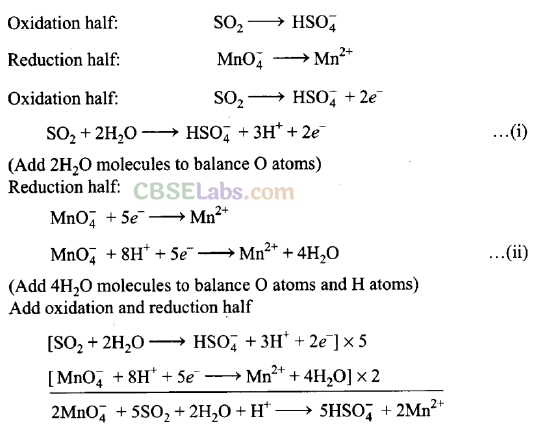
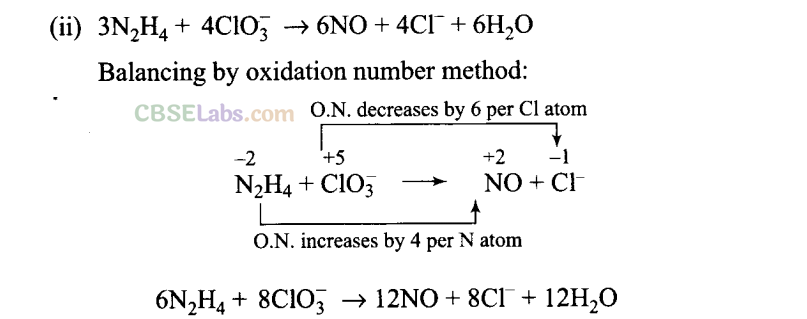
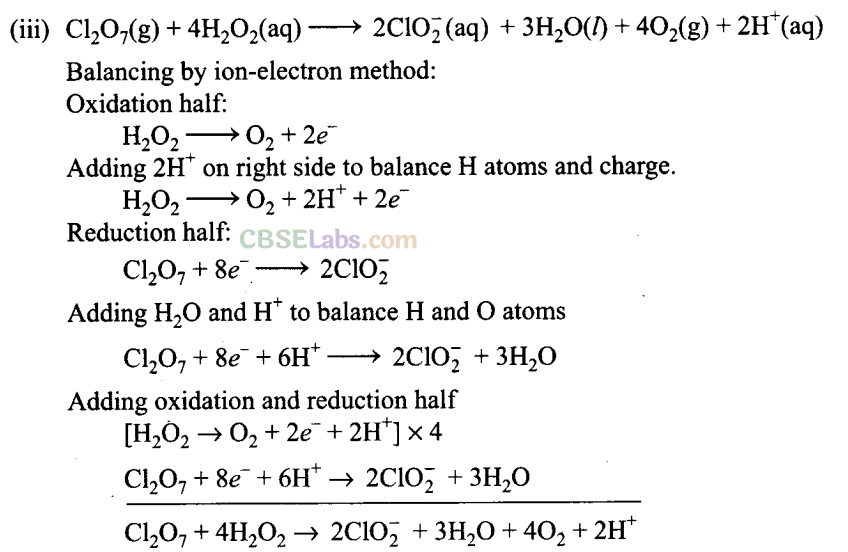
Q22. Calculate the oxidation number of phosphorus in the following species.
(a) HPO
3
2-
and (b) P0
4
3-
Sol:
(a) Let the oxidation number of P inHPO
3
2-
be x. So,
+1 + x + (—6) = —2 x = +3
(b)
Let the oxidation number of P in P0
3
4
–
be x. So, x + (-8) = -3
x = +5
Q23. Calculate the oxidation number of each sulphur atom in the following compounds:
(a) Na
2
S
2
0
3
(b) Na
2
S
4
0
6
(c) Na
2
S0
3
(d) Na
2
S0
4
Sol:
(a) Na
2
S
2
0
3
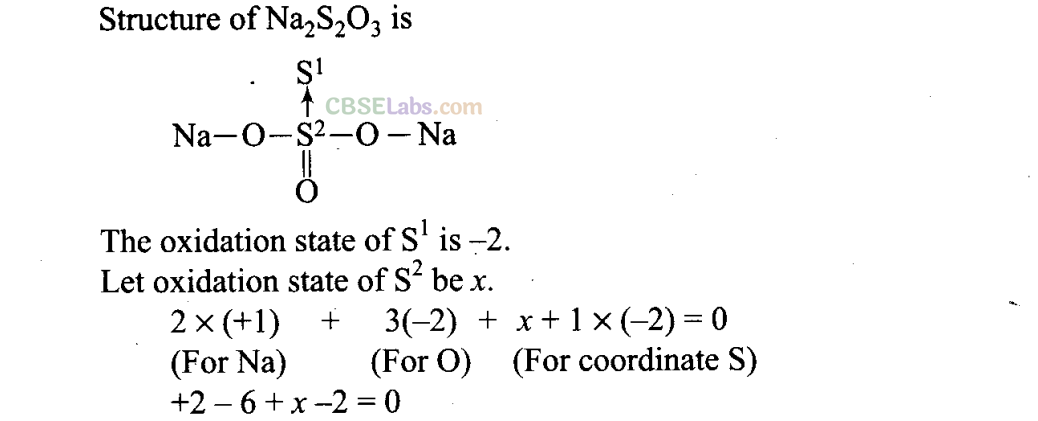
Thus, the oxidation states of two S atoms in Na
2
S
2
0
3
are -2 and +6.
(b) Na
2
S
4
0
6
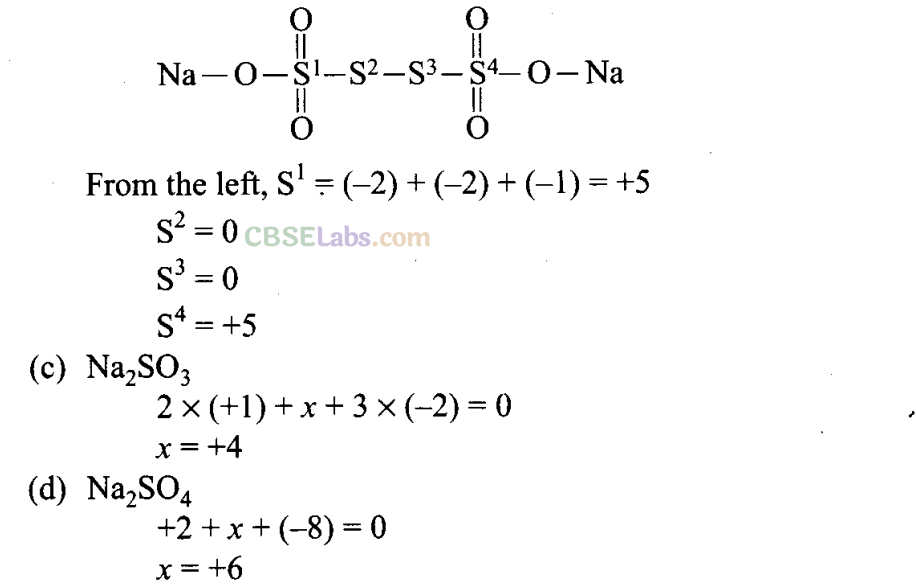
Q24. Balance the following equations by the oxidation number method.
(i) Fe
2+
+ H
+
+ Cr
2
0
7
2-
→Cr
3+
+ Fe
3+
+ H
2
0
(ii) I
2
+ N0
–
3
→ N0
2
+I0
3
(iii) I
2
+ S
2
0
3
2-
→I
–
+ S
4
0
6
2-
‘
(iv) MnO, + C
2
0
4
2-
→ Mn
2+
+ CO
2
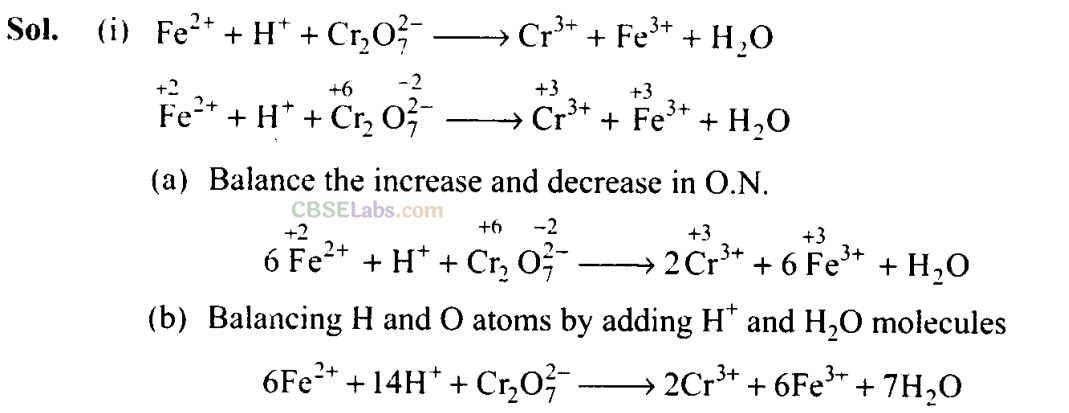
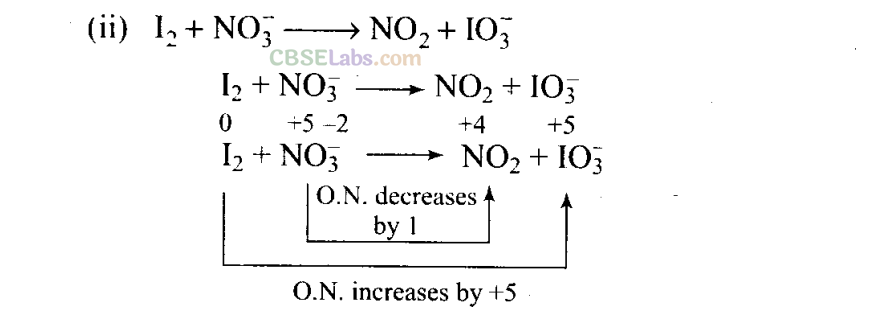
Total increase in O.N. = 5×2= 10
Total decrease in O.N. = 1
To equalize O.N. multiply NO
3
–
, by 10
I
2
+ 10no
3
–
→ 10no
2
+ IO
3
–
Balancing atoms other than O and H
I
2
+ 10no
3
–
→ 10NO
2
+ 2 IO
3
–
Balancing O and H
I
2
+ lO no
3
–
+ 8H
+
→ 10NO
2
+ 2 IO
3
–
+ 4H
2
0
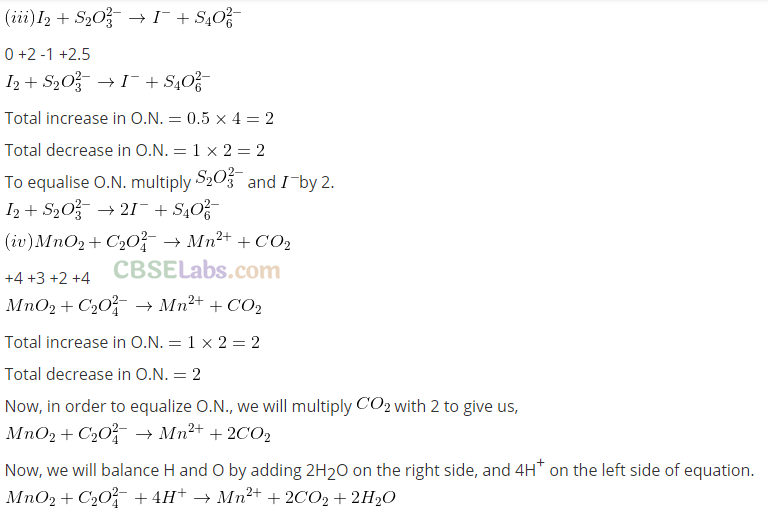
To equalize O.N. multiply C0
2
by 2. –
Mn0
2
+ C
2
0
2-
4
→Mn
2+
+ 2CO
2
Balance H and O by adding 2H
2
0 on right side, and 4H
+
on left side of equation.
MnO
2
+ C
2
0
2-
4
+ 4H
+
→Mn
2+
+ 2CO
2
+ 2H
2
0
Q25. Identify the redox reactions out of the following reactions and identify the oxidizing and reducing agents in them
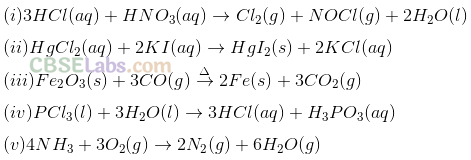
Sol:
(i) Writing the O.N. of on each atom,

Here, O.N. of Cl increases from -1 (in HCl) to 0 (in Cl
2
). Therefore, Cl
–
is oxidized and hence HCl acts as a reducing agent.
The O.N. of N decreases from +5 (in HN0
3
) to +3 (in NOC1) and therefore, HN0
3
acts as an oxidizing agent.
Thus, reaction (i) is a redox reaction.

Here O.N. of none of the atoms undergo a change and therefore, this is not a redox reaction.

Here, O.N. of Fe decreases from +3 (in Fe
2
0
3
) to 0 (in Fe) and therefore, Fe
2
0
3
acts as an oxidizing agent.
O.N. of C increases from +2 (in CO) to +4 (in C0
2
) and therefore, CO acts as a reducing agent. Thus, this is a redox reaction.

Here O.N. of none of the atoms undergo a change and therefore, it is not a redox reaction.

Here. O.N. of N increases from -3 (in NH
3
) to 0 in (N
2
) and therefore, NH
3
acts as a reducing agent. O.N. of O decreases from 0 (in 0
2
) to -2 (in H,0) and therefore, 0
2
acts as an oxidizing agent.
Thus, reaction (v) is a redox reaction.
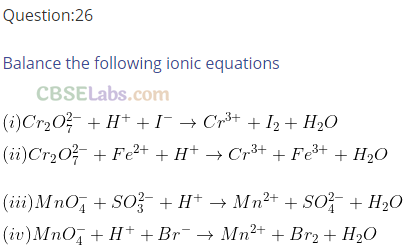

Dividing the equation into two half reactions:
Oxidation half reaction: I
–
→ I
2
Reduction half reaction: Cr
2
0
7
2-
→ Cr
3+
Balancing oxidation and reduction half reactions separately as:
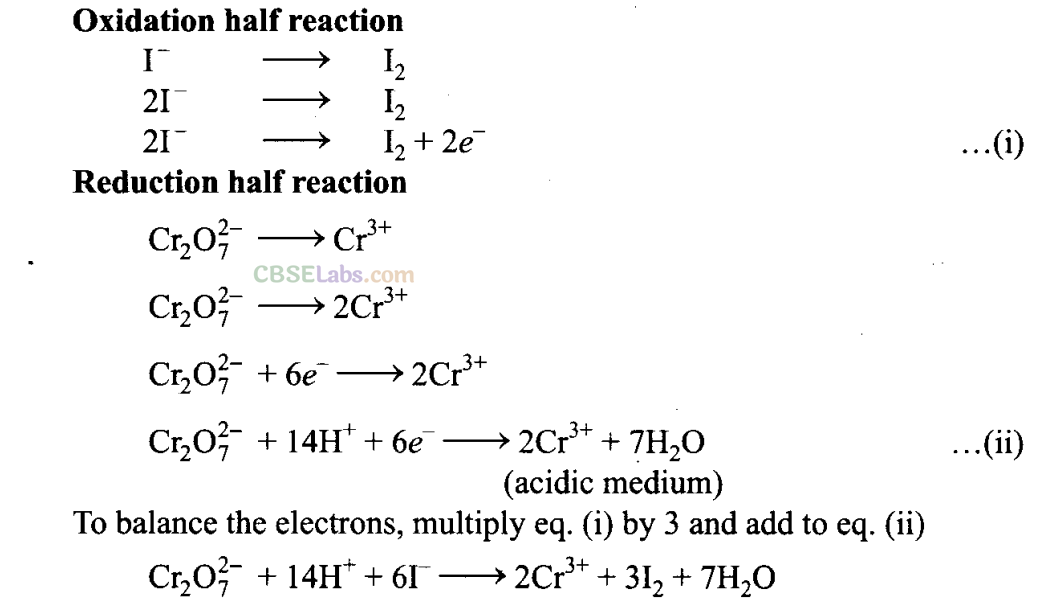
(ii) Step-1: Separate the equation into two half reactions.
The oxidation number of various atoms are shown below:
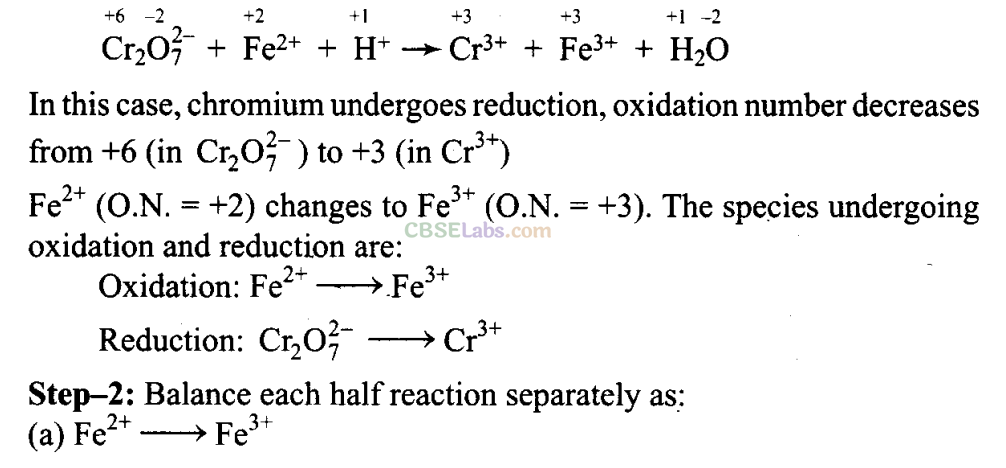
(i)
Balance all atoms other than H and O. This step is not needed, because, it is already balanced.
(ii)
The oxidation number on left is +2 and on right is +3. To account for the difference, the electron is added to the right as:
Fe
2+
→Fe
3+
+ e
–
(iii)
Charge is already balanced.
(iv)
No need to add H or O.
The balanced half equation is:
Fe
2+
→ Fe
3+
+ e
–
…(i)
Consider the second half equation
Cr
2
0
7
2-
→ Cr
3+
(i) Balance the atoms other than H and O.
Cr
2
0
7
2-
→2Cr
3+
(ii)
The oxidation number of chromium on the left is +6 and on the right is +3. Each chromium atom must gain three electrons. Since there are two Cr atoms, add 6e
–
on the left.
Cr
2
0
7
2-
+ 6e
–
→ 2Cr
3+
(iii)
Since the reaction takes place in acidic medium add 14H
+
on the left to equate the net charge on both sides.
Cr
2
0
7
2-
+6e
–
+14H
+
→2Cr
3+
(iv) To balance FI atoms, add 7H 2 O molecules on the right.
Cr 2 0 7 2- + 6e – + 14H + → 2Cr 3+ + 7H 2 0 .. .(ii)
This is the balanced half equation.
Step-3: Now add up the two half equations. Multiply eq. (i) by 6 so that electrons are balanced.
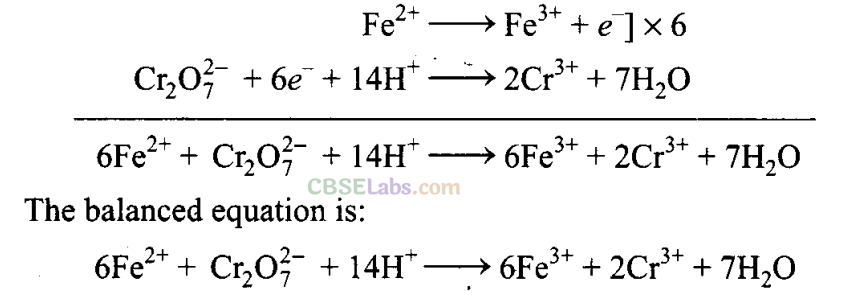
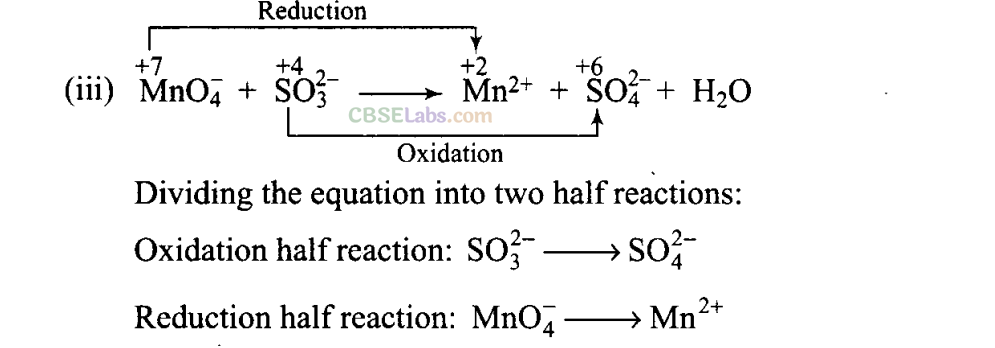
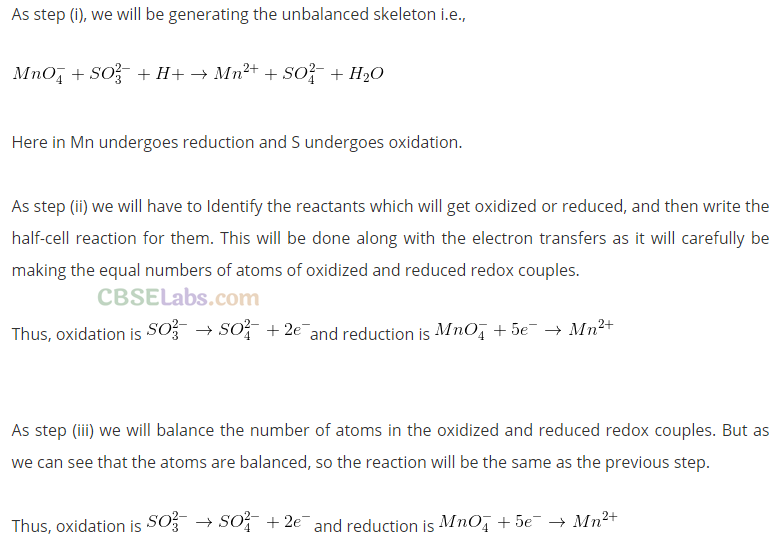
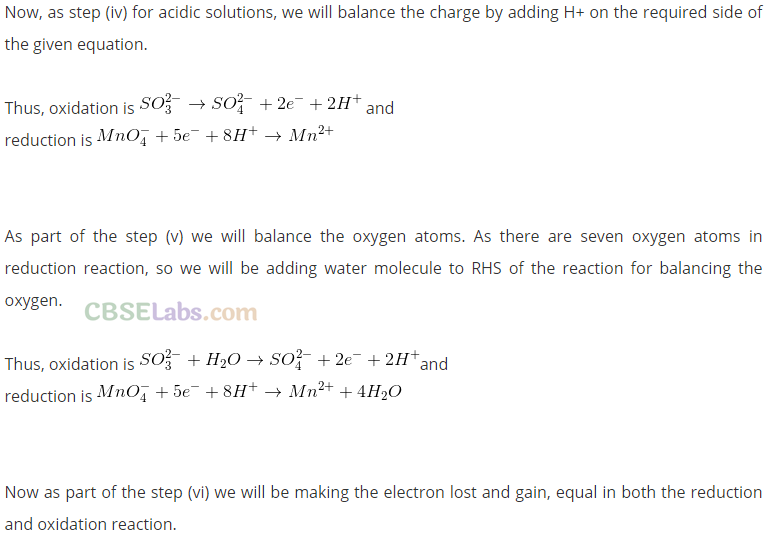
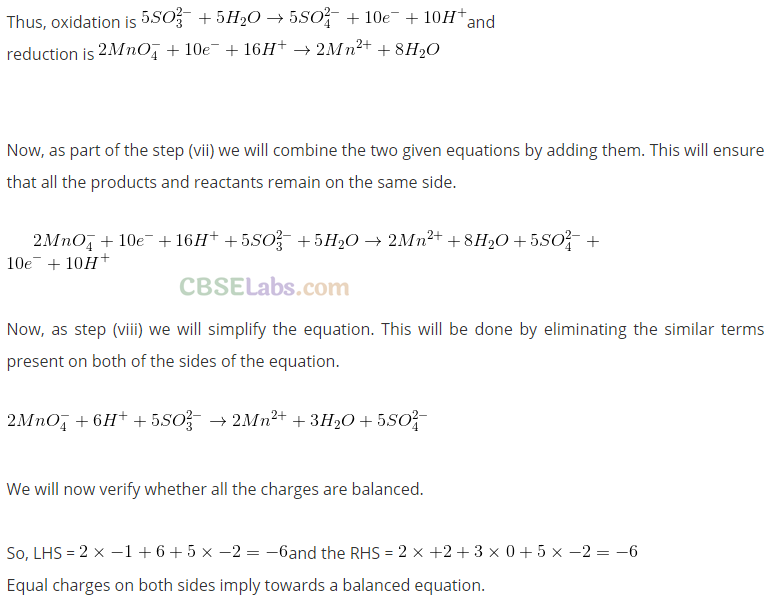
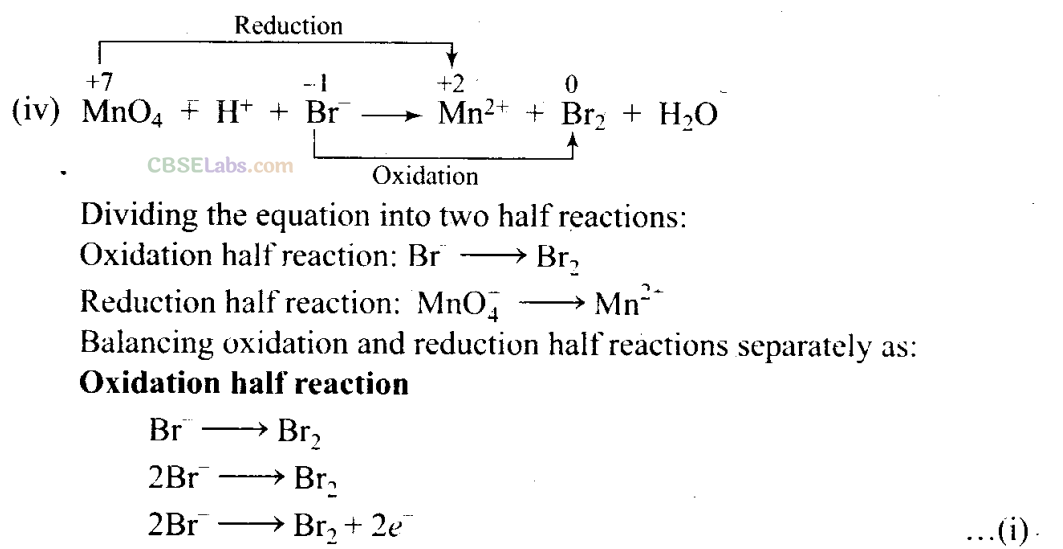
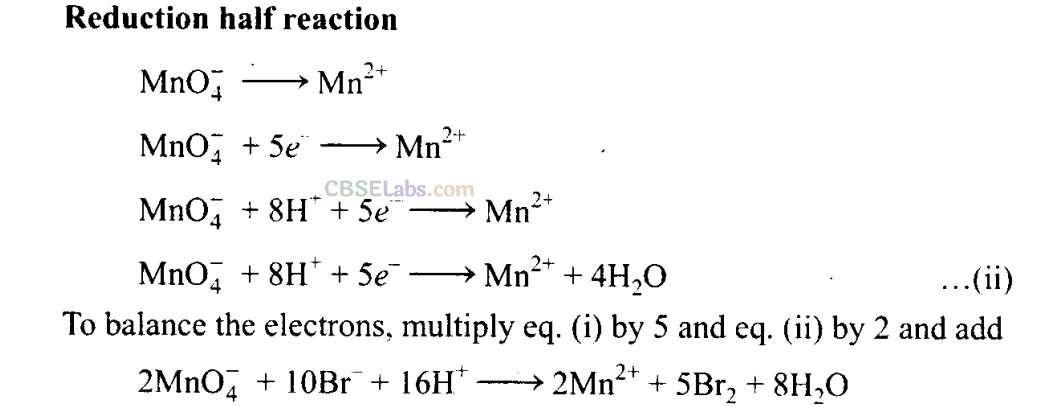
NCERT Exemplar Class 11 Chemistry Solutions
- Chapter 1 Some Basic Concepts of Chemistry
- Chapter 2 Structure of Atom
- Chapter 3 Classification of Elements and Periodicity in Properties
- Chapter 4 Chemical Bonding and Molecular Structure
- Chapter 5 States of Matter
- Chapter 6 Thermodynamics
- Chapter 7 Equilibrium
- Chapter 8 Redox Reactions
- Chapter 9 Hydrogen
- Chapter 10 The s-Block Elements
- Chapter 11 The p-Block Elements
- Chapter 12 Organic Chemistry: Some Basic Principles and Techniques
- Chapter 13 Hydrocarbons
- Chapter 14 Environmental Chemistry